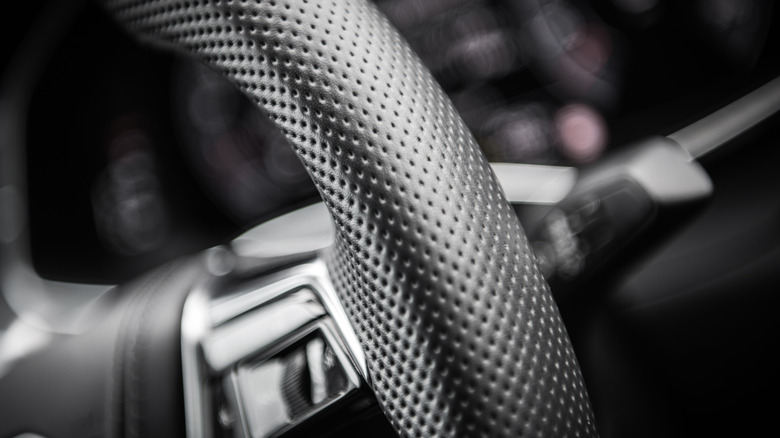This Trick Makes It Easy To Put On A Steering Wheel Cover
We may receive a commission on purchases made from links.
Installing an aftermarket steering wheel cover can provide many benefits for your ride. It not only serves to spruce up your car's interior, but it could make old cars look newer by covering wear marks like rips, tears, and blemishes on the steering wheel rim. Steering wheel covers will also preserve a brand-new steering wheel and keep it looking pristine as the miles pile up. Meanwhile, car enthusiasts look into steering wheel covers to make the tiller feel thicker and girthier, which is a good thing to have if you like driving aggressively and need more grip.
Whenever I buy a used car — whether for keeps or flipping it for cash — I typically install a steering wheel cover to revitalize the cabin. And when we get our hands on a pristine used car with low miles, protecting the parts of the cabin that the driver touches the most, like the steering wheel and the gear lever, is usually the day's first order to keep 'em looking newer for longer.
Steering wheel covers come in many sizes, materials, and designs, but all share a common trait: They could be challenging to install. I know this after being at the helm of various car models since late adolescence. Steering wheel covers are an affordable way to decorate or personalize any car, but I want to share a handy trick that makes it almost effortless to install, whether you have a car, truck, or SUV with a small, large, or extra cool-looking steering wheel.
Installing a steering wheel cover? Let it warm
If you paid a smidgen of attention to science class in high school, we know that higher temperatures reduce material stiffness. On the other hand, low temperatures increase the stiffness or strength of a material. Think of it as a banana in the freezer, which solidifies and becomes rock-hard after a few hours in the chiller. Leave a similar banana under the hot sun, and you'll end up with an overripe, super-soft fruit.
With leather, cloth, or vinyl materials, mildly heating a steering wheel cover can make them easier to install. Before doing anything, ensure you ordered the correct size for your steering wheel and wipe the rim clean before covering it up. Grab a clean microfiber towel moistened with water and mild soap and wipe gently all over the steering wheel rim. If your car has a leather and stitched steering wheel, you can use an old, soft-bristled toothbrush dipped in soapy water to clean the stitching. Wipe everything dry with a separate cloth before proceeding.
The last step is to place the steering cover on the dashboard and park your vehicle under the sun for 10-15 minutes, giving it enough time to absorb the heat and "soften up." Avoid using heat guns or a hair dryer, which could damage the steering wheel cover. Once the steering wheel cover is warm enough, it will be easier to place and wrap around the wheel. Silicone wheel covers are easier to install and won't need warming up since they are more flexible, but this technique works wonders on leather or PVC steering covers.

